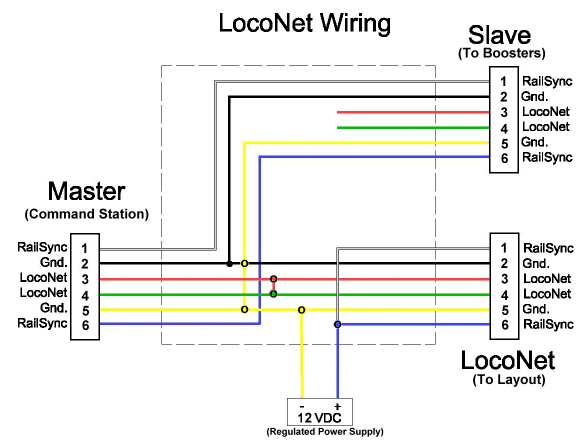Introduction
LocoNet devices such as throttles are normally powered from the
RailSync lines (1 and 6) in the LocoNet cable and send and receive
their information on the LocoNet lines. Boosters actually receive their
signals from the RailSync lines, and do not send or receive any
information on the LocoNet. Both types of information are normally
carried in the same LocoNet wiring. Note: Digitrax detector boards
require both RailSync and LocoNet connections. They will not work if
these modifications are made to the bus wiring. Connect them directly
to the Master LocoNet section.
Background
To protect the small gauge wiring in the typical LocoNet cable the current is limited to less than one amp by series resistors in the command stations. Unfortunately this series resistance causes a voltage drop in the RailSync signal for every connected device. On large layouts with many throttles this quickly results in a voltage insufficient to operate throttles properly without batteries, and those with batteries discharge rapidly.
On very large layouts there can also be a deterioration of the LocoNet signals due to cable capacity. (over 1000' of cable)
Solution
Figure 1: Wiring schematic to split RailSync from throttle power
How It Works
Boosters only require the RailSync signals to operate. Throttles and most other LocoNet devices only use the RailSync as a source of power. They can also work directly from DC power which is what happens in a Digitrax UP-5 panel when it is powered from a wall wart. Long LocoNet networks may also benefit by the reduction in total cable length of the LocoNet wires. This wiring splits the Loconet into two sections. The 'Slave' section is only used to provide the RailSync signals to the boosters. Throttles and accessory devices will not work if they are connected to the 'Slave' wiring. The 'LocoNet' section has the RailSync isolated and replaced with DC power from a small (500ma.) wall wart supply. That provides ample clean power for throttles and accessory devices without loading down the RailSync signals. Boosters will not work if they are connected to the 'LocoNet' section of the wiring. Label the two different lines to keep them distinct.
Be sure that there is no connection made between the two different LocoNet cables or the RailSync lines will be shorted out and the system will not work.
Modifications
All the modifications are made inside of the area marked with dashed lines.
Potential Problems
Some LocoNet Boosters are also able to operate as command stations. These units may expect to be able to automatically switch to the correct mode based on the LocoNet traffic. These may not operate properly on the booster only section. Some devices such as the Digitrax BDL series of occupancy detectors require the RailSync lines to operate properly, and will not work properly on a Throttle only network. Wire them directly to the Master LocoNet section.
Options
If you use UP-5 panels from Digitrax be sure to power them from one or more wall warts. Run the power wiring (shown as an option in the UP-5 directions) to each panel. Be sure that you only connect boosters to the rear wiring jacks and connect all your throttles to the front jacks. This essentially does the same as shown above by providing isolated DC power to the throttles.
